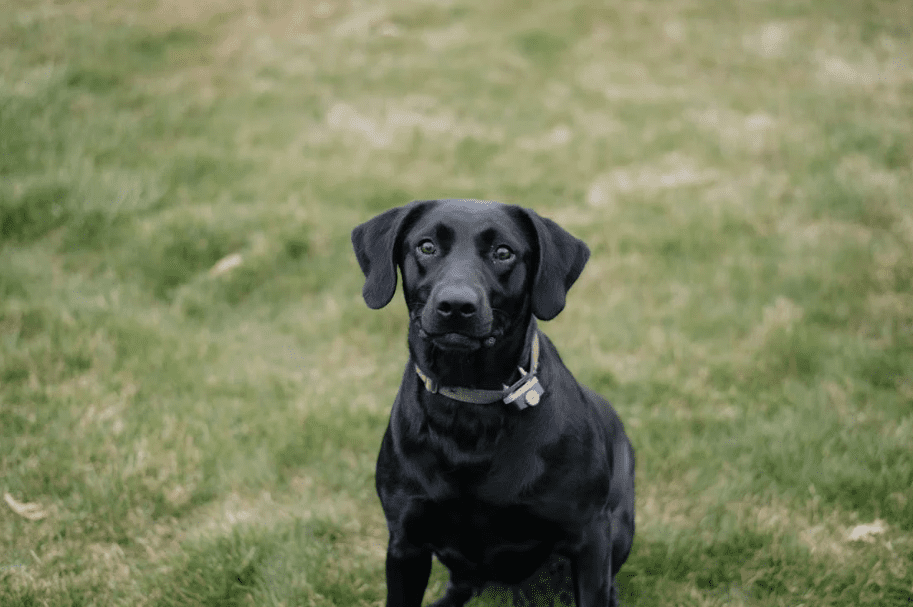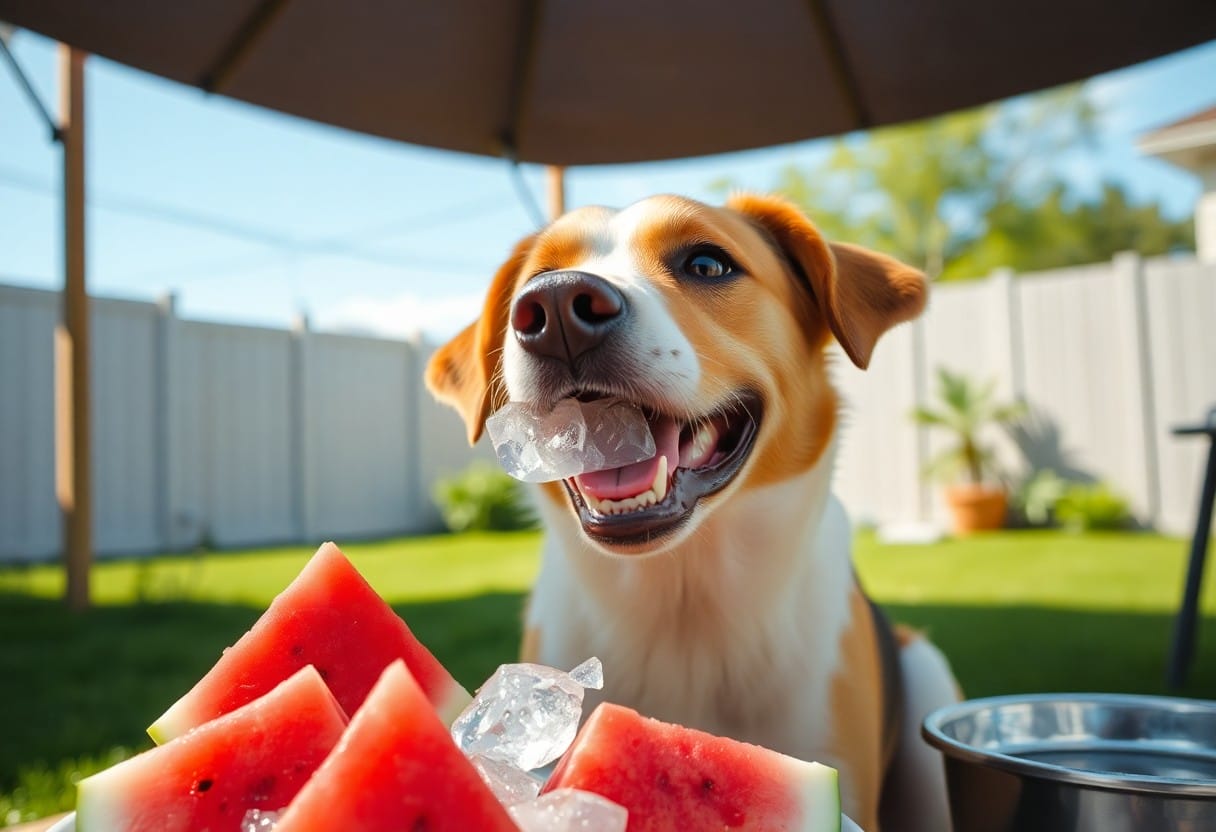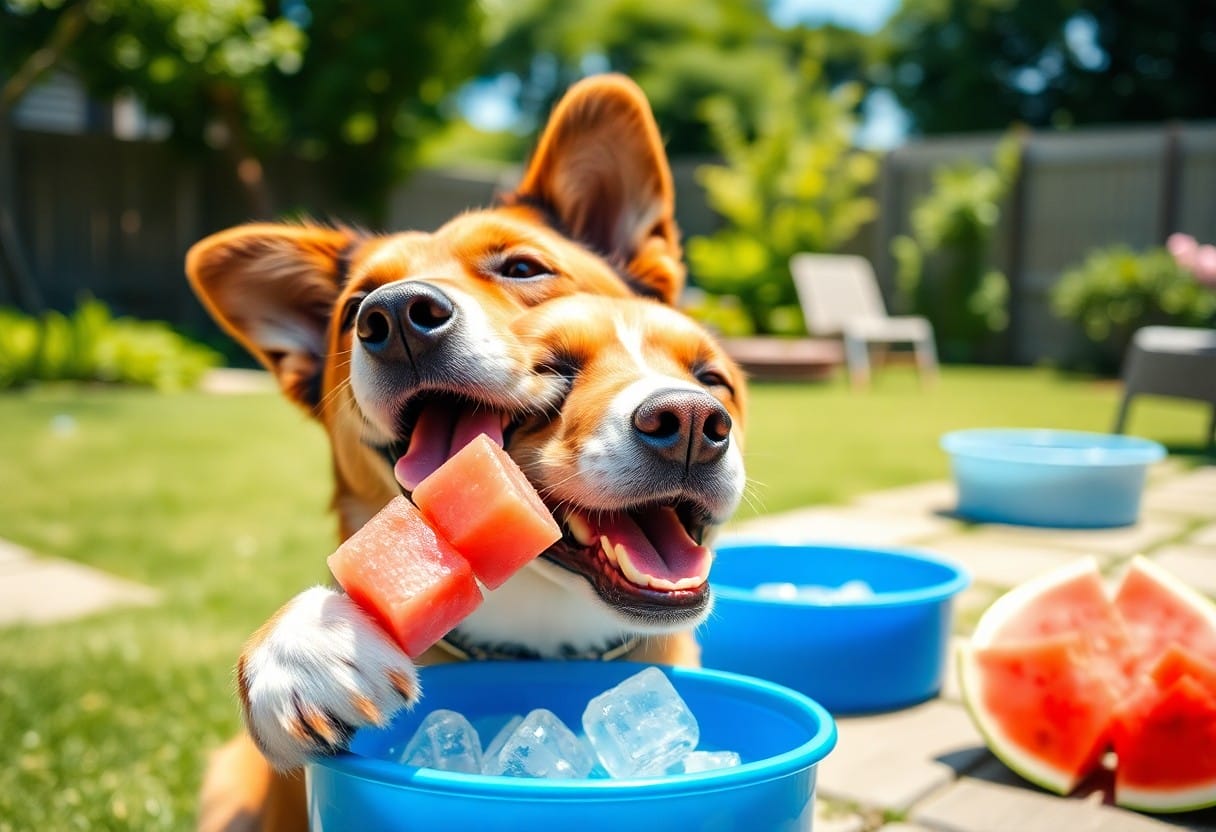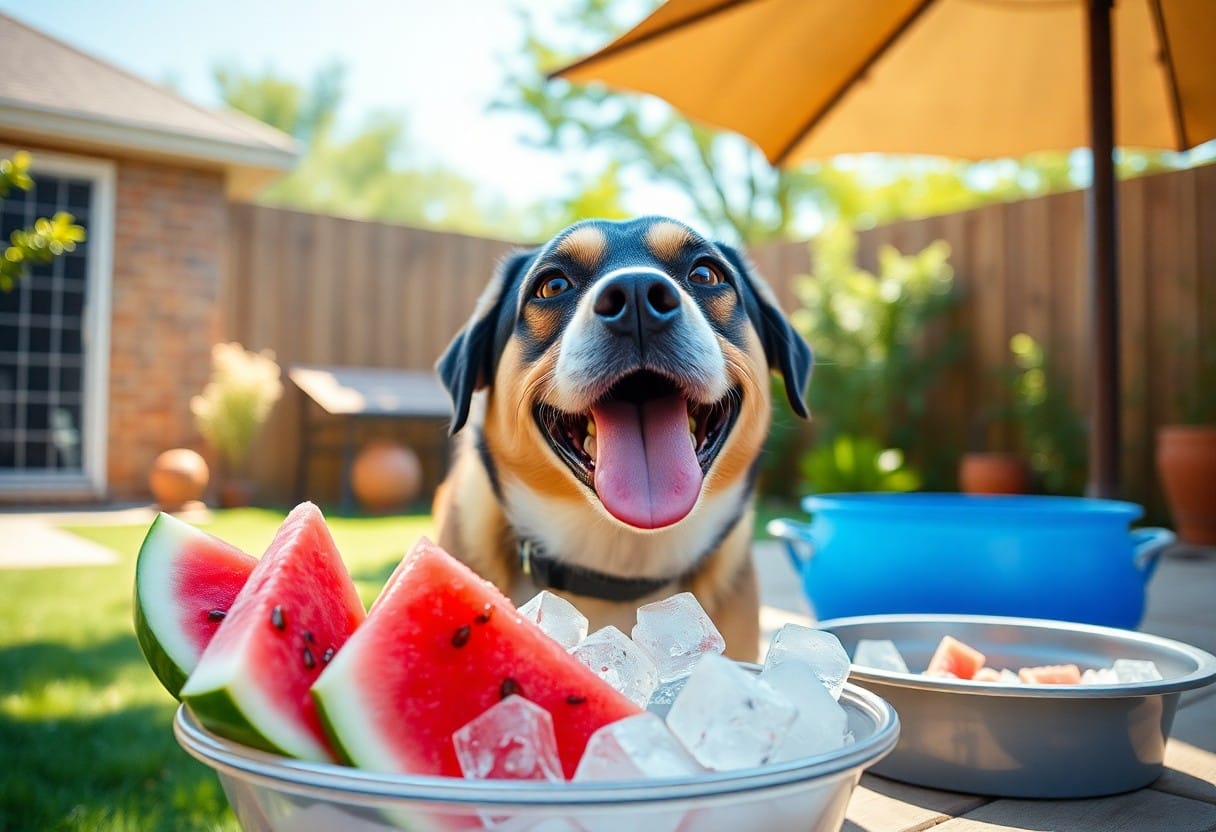
Keeping Your Dog Cool in Summer - Hydrating Snacks & Tips
Share
It's vital to keep your dog hydrated and comfortable during the hot summer months. As temperatures rise, your furry friend may be at risk of overheating, which can lead to serious health issues. Incorporating hydrating snacks and proper care routines can help ensure your pet stays cool. In this blog post, you will discover simple tips and tasty treats that provide moisture and keep your dog feeling their best, ensuring a fun and safe summer for both of you.

Key Takeaways:
- Hydration is Essential: Ensure your dog has access to fresh water at all times to prevent dehydration in hot weather.
- Cooling Snacks: Offer hydrating snacks like frozen fruits, low-sodium broth ice cubes, or special pet-safe frozen treats to help keep your dog cool.
- Shade and Rest: Provide shaded areas for your dog to rest and avoid strenuous activities during the hottest parts of the day.

Understanding Canine Heat Stress
The summer months can pose significant challenges to your dog's well-being, particularly when it comes to heat stress. As the temperatures rise, your furry friend is at an increased risk of overheating, which can lead to serious health concerns if not addressed promptly. Dogs do not sweat like humans; instead, they rely on panting and other behaviors to regulate their body temperature. When temperatures soar, you need to be vigilant about your dog's comfort and safety, ensuring they stay cool and hydrated.
Signs of Overheating
Among the most important aspects of preventing heat-related issues is your ability to recognize the signs of overheating in your dog. Common symptoms include excessive panting, drooling, weakness, and an increased heart rate. You might also notice your dog behaving restlessly, seeking cooler surfaces, or appearing lethargic. Understanding these warning signs allows you to take action quickly and prevent serious health complications.
Risks of Dehydration
Heat amplifies the risk of dehydration in dogs, especially when engaging in outdoor activities. Dehydration can lead to a host of problems, including kidney damage, impaired circulation, and, in severe cases, can even be life-threatening. Dogs with limited access to fresh water or those that are overly active are particularly susceptible. When your dog becomes dehydrated, their body may struggle to regulate temperature, accelerating the risk of heat stress and further complications.
For instance, it is necessary to provide your dog with ample fresh water at all times, especially during hot days. If you notice your dog is showing signs of dehydration, such as dry gums or loss of skin elasticity, it's important to offer them water and encourage them to drink. In extreme cases, you may need to contact a veterinarian immediately to assess their condition and administer necessary treatments, such as IV fluids. By taking proactive measures to ensure your dog remains hydrated, you greatly reduce the risks associated with heat stress and dehydration.

Hydrating Snacks for Dogs
Some of the best ways to keep your dog hydrated during the hot summer months are through hydrating snacks. There's a myriad of delicious and refreshing options you can prepare or find at your local pet store. You can also join conversations on platforms like How are you keeping your dogs cool and hydrated this ... to get creative ideas from fellow dog owners. Ensuring your pet has access to these treats can not only help keep their hydration levels up but also add enjoyment to their day, taking the edge off the heat while satisfying their taste buds.
Homemade Frozen Treats
Before plunging into the world of homemade frozen treats, consider simple ingredients your dog loves. You can blend fruits like watermelon, blueberries, or bananas with some yogurt and pop them into ice cube trays. These treats not only hydrate your pup but can also provide some imperative vitamins and nutrients. Once frozen, you'll have delicious snacks that will keep your dog busy while they enjoy some relief from the heat.
Store-Bought Options
The market is filled with various store-bought options that are specifically designed to keep your dog cool and hydrated. Many brands offer frozen treats made from natural ingredients, perfect for those days when you don't have time to whip up homemade versions. Make sure to check the labels for ingredients that are free from additives and dangerous substances like xylitol, which is toxic to dogs.
Understanding what to look for in store-bought options can significantly affect your dog's health and happiness. Look for snacks that contain natural ingredients and adequate hydration properties. Many pet companies are now producing frozen yogurts or bone broths packed with vitamins and nutrients, specifically made for dogs and ideal for hot weather. Before giving any new treat, it's always best to introduce it gradually to ensure your pet reacts positively and stays safe.
Creating a Comfortable Environment
Once again, as the summer heat intensifies, it's vital to foster a comfortable environment for your dog. A few simple changes within your home and yard can go a long way in keeping your furry friend feeling cool and relaxed during the hot months. Make it a priority to provide ample ventilation and ensure your dog has access to shaded areas, both indoors and outdoors. This not only helps to regulate their body temperature but also offers a place where your pet can retreat when the heat becomes overwhelming. You can also consider adjusting your home's temperature with fans or air conditioning to create a more hospitable atmosphere.
Shade and Shelter
About providing your dog with adequate shade and shelter, it's important to assess your outdoor spaces. Whether it's a dog house, a covered patio, or large trees, these areas offer your dog respite from the sun. Make sure that any outdoor shelter is well-ventilated to avoid trapping heat inside. If you're frequently outside with your dog, set up a shaded area using umbrellas or beach tents, where they can chill out while you're enjoying the sun. Placing a comfortable bed in these shady spots can encourage your dog to stay cool without feeling trapped or exposed to direct sunlight.
Cooling Mats and Vests
Environment plays a significant role in your dog's comfort during summer months, and one effective way to combat heat is through cooling mats and vests. These products are specifically designed to lower your dog's body temperature and provide them relief from the heat. Cooling mats often use special gel to create a refreshing surface that your pet can lie on, while cooling vests absorb your dog's body heat and can be soaked in water for extra cooling action. Placing a mat in your dog's favorite relaxation spot or using a vest during walks can be great strategies to keep your dog comfortable.
Hence, investing in quality cooling mats and vests offers immediate benefits for your dog during the sweltering summer days. Make sure to choose products that are easy to clean and are made from safe, durable materials. Additionally, check the fit of cooling vests to ensure they are not too tight or loose, as this plays a significant role in their effectiveness. These tools can help your dog cope with the heat efficiently, allowing them to enjoy the outdoors while minimizing the risk of overheating.
Important Tips for Outdoor Activities
Keep your furry friend safe and comfortable during outdoor activities by adopting some simple habits. The summer heat can be overwhelming for dogs, so make sure to stay vigilant about their well-being. Here are a few tips to ensure a pleasant experience:
- Choose shaded areas for breaks.
- Limit strenuous activities during peak heat hours.
- Ensure your dog is well-hydrated before heading out.
- Consider protective gear, like dog boots to protect their paws from hot pavement.
- Be aware of your dog's stamina and adjust your plans accordingly.
Taking these steps will allow you to enjoy your time outdoors while keeping your dog happy and healthy.
Best Times for Walks
With the summer sun blazing down, selecting the right time to walk your dog is vital. Early mornings and late evenings tend to be cooler, providing a more comfortable environment for your pet. Try to plan your walks when the temperature is between 60 and 75 degrees Fahrenheit, as this range is often safer for your four-legged companion. Avoid walking during the hottest parts of the day, which usually falls between 10 a.m. and 4 p.m.
Water Breaks
Outdoor activities can lead to dehydration, especially in sweltering weather. It's important to schedule regular water breaks throughout your time outside to keep your dog hydrated. Carry a portable water bowl and ensure your dog drinks plenty of water every 15-30 minutes during breaks. This is especially important if you're exercising or hiking together.
Another aspect to consider is the importance of monitoring your dog for signs of overheating, which can be serious. Look for excessive panting, excessive drooling, or signs of lethargy. If you notice any changes in behavior, it may be necessary to take immediate action by cooling them down with water or finding shade. Ensure that your dog has access to fresh, cool water at all times, especially after engaging in any physical activity. Any signs of distress should not be taken lightly, as they could lead to serious health issues.
Hydration Strategies
After a fun day of outdoor activities, keeping your dog hydrated should be a top priority. A good hydration strategy is necessary, especially during the sweltering summer months. This can not only help your dog maintain a healthy temperature but also keep their energy levels steady. By following various approaches, you can ensure that your furry friend has access to the necessary fluids they need to stay happy and healthy.
Adding Water to Food
Beside providing fresh water at all times, consider enhancing your dog's diet by adding water to their food. This simple adjustment can significantly increase their overall water intake. You can use warm water to soak dry kibble, making it easier for your dog to eat while also promoting hydration. For those who feed their dogs wet food, mixing in some additional water can help create a palatable and hydrating meal that your dog will love.
Flavoring Water for Encouragement
Around the warmer months, your dog may need a little extra motivation to drink water. Flavoring your dog's water can make it more enticing, encouraging them to hydrate more regularly. You can try adding low sodium broth or a splash of coconut water to their water bowl. Just ensure that whatever you add is safe for dogs and does not contain any harmful ingredients, such as onion or garlic. Keeping their water station fresh and interesting is key to promoting healthy hydration practices.
A few drops of dog-friendly natural flavorings can go a long way in making water appealing. Additionally, consider using ice cubes infused with fruits like blueberries or watermelon (without seeds) for a refreshing treat on hot days. This can be a fun and safe way to offer flavors your dog enjoys while keeping them hydrated and cooling them off at the same time. Always pay attention to how your dog reacts to these flavorings, ensuring their enjoyment does not change their regular drinking habits.
Monitoring Your Dog's Health
Not only is keeping your dog cool in the summer about providing hydration and shade, but it also involves closely monitoring their health. You should pay attention to any signs of overheating, such as excessive panting, drooling, or lethargy. Keeping track of these symptoms can help you intervene before a serious issue arises. Consider what you feed your dog in the summer months as well. Feeding them chilled food can aid in lowering their body temperature while providing necessary nutrition.
Regular Checks During Hot Days
Days in the summer heat can be tough for your dog, especially if they are not acclimated to high temperatures. Regularly check your dog's water bowl to ensure they have access to fresh water at all times. Short, frequent breaks during walks can also help manage exposure to heat. Pay attention to your dog's energy level and behavior after activities; if they seem unusually tired, it can be an indication that they are overheating.
When to Seek Veterinary Care
Along with regular checks, recognizing when to seek veterinary care is key to maintaining your dog's health during hot weather. If your dog develops a rapid heartbeat, refuses to drink, or shows signs of distress, this could indicate heat-related illness. Specific symptoms such as weakness, confusion, or vomiting should prompt immediate veterinary attention. Being aware of these signs can be the difference between a quick recovery and severe health issues.
Health conditions can rapidly escalate during the hot months, so it's important to stay vigilant. Should you notice signs of severe dehydration, collapse, or uncontrolled vomiting, don't hesitate to get your dog to the vet as soon as possible. Early intervention can save your dog from serious complications related to heat exposure. Establishing a good routine for monitoring your furry friend not only enhances their summer experience but also helps you avoid potential dangers that come with warmer temperatures.
To wrap up
Now that you are equipped with various strategies to keep your dog cool during the scorching summer months, it's vital to implement these practices consistently. Providing hydrating snacks such as frozen fruits or flavorful ice cubes made from their favorite broth can transform a hot day into a refreshing experience for your furry friend. Additionally, ensure that your dog has access to clean, fresh water at all times and consider scheduling walks during the cooler parts of the day. Your attentiveness to their comfort will help prevent any heat-related issues and promote their overall well-being.
By being proactive and incorporating these tips into your routine, you can create a safe and enjoyable summer environment for your pet. From summer-themed games to exploring shady spots during outings, you have numerous ways to enhance your dog's summer experience. It's all about being attentive to your dog's needs and adjusting your activities to align with the rising temperatures, allowing for both fun and safety. Your commitment to keeping your dog cool will undoubtedly foster a happy and healthy summer for both of you.
Frequently Asked Questions
What are some hydrating snacks I can give my dog in the summer?
A: There are several hydrating snacks that are perfect for keeping your dog cool in the warmer months. Watermelon, without seeds or rind, is a tasty treat that most dogs love and is high in water content. Cucumber slices are also refreshing and low in calories. You can freeze low-sodium chicken broth in ice cube trays to create tasty broth ice cubes. Additionally, consider making pup-sicles by blending yogurt with fruits and freezing them as a delicious snack.
How can I tell if my dog is overheated and needs to cool down?
A: Signs of overheating in dogs can include excessive panting, drooling, weakness, or lethargy. If you notice that your dog is seeking shade, pacing, or has a rapid heartbeat, they may be too hot. It's important to check their temperature; a normal dog temperature ranges from 101°F to 102.5°F. If their temperature rises above this range significantly, it's time to take action to cool them down.
What are some tips to keep my dog cool during outdoor activities?
A: To keep your dog cool while enjoying outdoor activities, schedule walks or playtime during the cooler parts of the day, such as early morning or late evening. Bring plenty of water for hydration and take breaks in the shade to allow your dog to cool down. You can also use a cooling vest or bandana, which can help lower their body temperature. Finally, consider providing access to a kiddie pool or wet towels they can lie on to help them cool off.
Are there specific signs that indicate my dog is dehydrated?
A: Yes, there are several signs of dehydration to look out for in your dog. You may notice that their gums are dry or sticky, their skin loses elasticity (by gently pinching the skin—it should snap back), or they may have a decreased level of energy. Other indicators include increased panting, a lack of appetite, or darker urine than usual. If you observe any of these signs, it's important to provide them with water immediately and consult a veterinarian if symptoms persist.
How often should I provide water and snacks to my dog on hot days?
A: On hot days, your dog should have access to fresh water at all times, and it's a good idea to encourage them to drink regularly. In addition to their regular feeding schedule, offering hydrating snacks a few times throughout the day can help keep them cool. Aim to provide these snacks, especially after exercise or outdoor play, and monitor how much they are consuming based on their activity level and temperature. Always have extra water available when they are enjoying outdoor activities.
